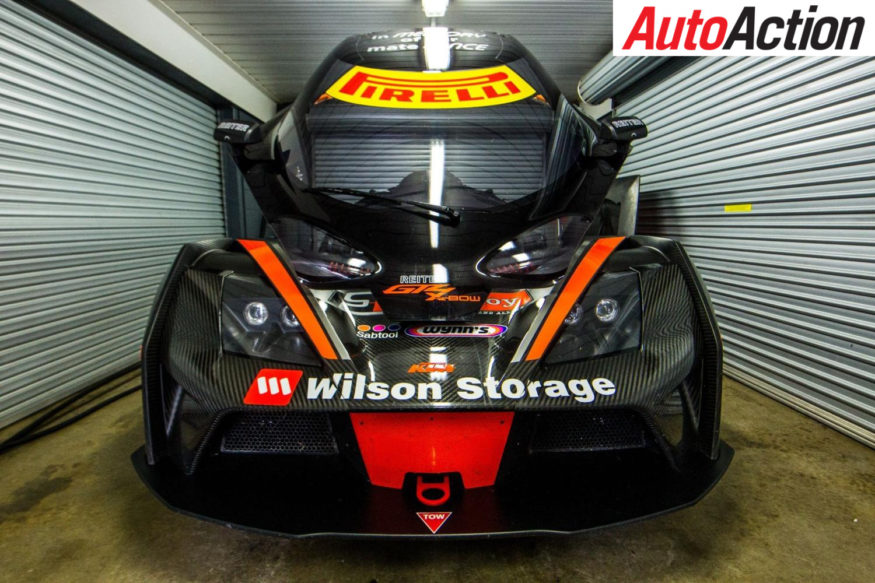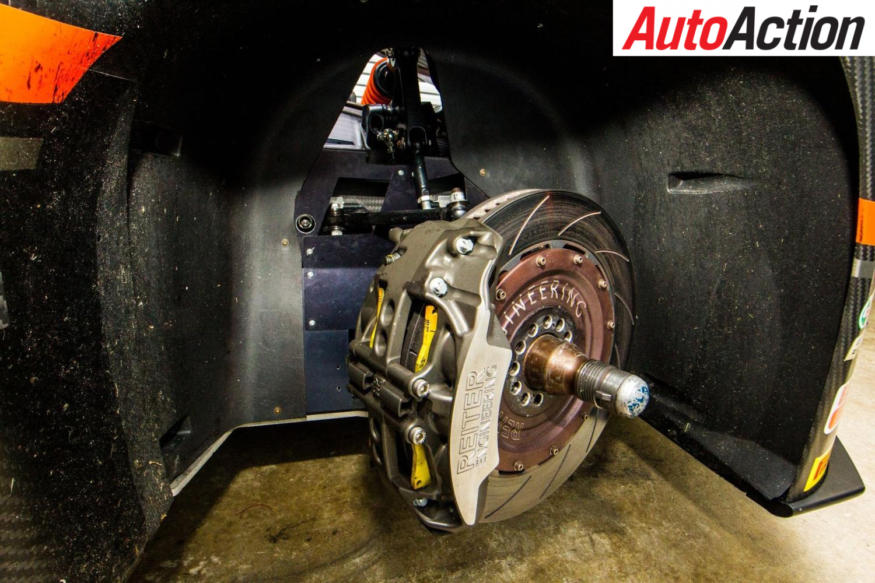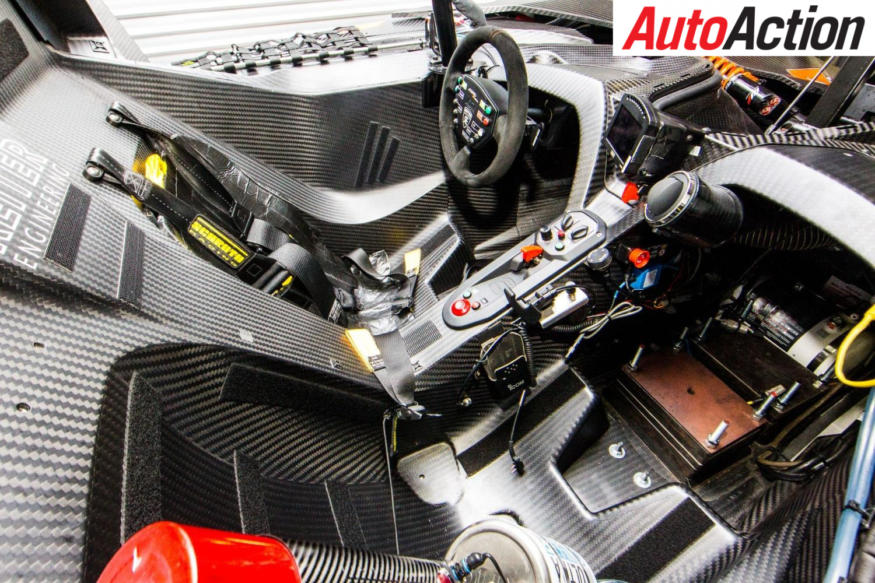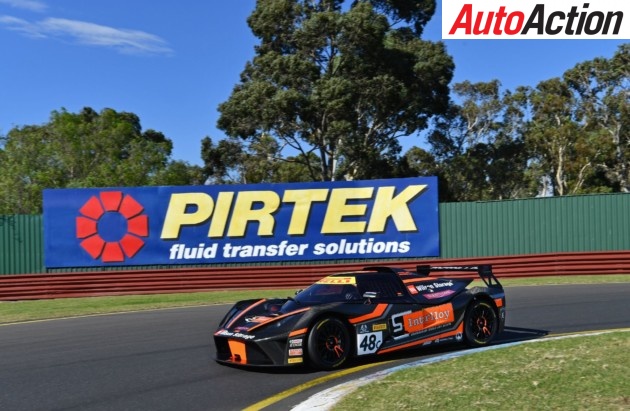UNDER THE SKIN: KTM X-BOW GT4 – KEEPING THE MOMENTUM


Under The Skin of a KTM X-Bow
KTM is best-known as a manufacturer of off-road motorcycles but the X-Bow GT4 goes some way to changing that perception…

The KTM X-Bow GT4 on track at Sandown
THE DESERTS of South America are well-known to competitors in the annual Dakar Rally. So too, to devotees of motorcycle GP road racing, are the classic circuits at Mugello and Aragon.
But when Toby Price won the Dakar in 2016, and Brad Binder took out the Moto3 title a few months later, there was a link with what happens in the GT fields at Silverstone, Road American and Bathurst.
KTM is best-known for its success in bikes from Dakar to the circuits of MotoGP. Ten years ago KTM it built its first car, the edgy, open-top sportscar named the X-Bow. The Austrian built its first generation racer for the 2008 European GT4 Championship, in which it competed in the Supersport Class. Christopher Haase took the title behind the wheel of the car run by Reiter Engineering, which also undertook the development and build of the new car.
The current incarnation of the X-Bow, now a closed-top car, has seen the successes continue in both Europe and America, where the car took championship victory in the Pirelli World Challenge.
But is has not been easy. GT4 is currently in the midst of a boom period world-wide, as a multitude of manufacturers have announced GT4 customer programs for 2018. But in 2014, when the car was introduced, there was something of a downturn in GT4, though Reiter Engineering team boss Hans Reiter was confident that there would be a resurgence in the class. His prediction has proven to be accurate.
“Now is the ideal time to introduce a revolutionary new vehicle concept into international customer motorsport,” Reiter said three years ago.
“This is an opportunity I did not want to miss and I presented my ideas to KTM. I’m convinced that the new model will attract a lot of interest and will be very successful internationally.”
His faith has been rewarded. The Stephane Ratel Organisation, which oversees the organisation of the class world-wide, introduced two GT4 specific championships covering the north and south of Europe. Meanwhile in Britain GT$ has become a stronger class than its outright GT3 class. The Pirelli World Challenge introduced GT4 to the Americans, but the Continental Sports Car Challenge has exploded courtesy of introducing the GT4 rulebook this year.
Australian distributor and M Motorsport team owner Justin McMillan is confident that, with Supercars now involved in the promotions of GT racing in Australia, GT4 will grow locally, despite a relatively slow start.
“Hopefully GT4 will get the traction GT3 has under SuperGT and then it should start to take off,” enthused McMillan.
The main difference, which is somewhat obvious, is the difference in price between GT3 and GT4. It may be a given, considering its specs and size, but by how much is a surprise. The GT4 car is lighter, yes the engine is smaller, leading to the little KTM hardly turning a wheel wrong since debuting at the Bathurst 12 Hour earlier this year. Maintenance-wise, it has been a dream for the M Motorsport crew, who have hardly had to replace a thing according to McMillan.
“We’ve done 6000km in this car and we haven’t even replaced a clutch or anything. We’re on our third set of front rotors, so the running costs you can’t even compare.”
With KTM’s somewhat limited expertise in developing cars, it comes as little surprise that some of the proprietary technology in the X-Bow comes from a familiar source, given that Reiter Engineering has a long history with Lamborghini. That gives the KTM something of a head start…
“It doesn’t wear out brakes, it doesn’t wear tyres,” says McMillan.
“The four corners are Lambo corners anyway, with bearings, spindles and uprights, so the wear of components is a lot less.
“We did the [Bathurst] 12 hour in it earlier this year and the running costs are nothing like a GT3. We used three sets of DH Pirellis for the whole weekend. Some of the other GT teams had $50,000 tyre bills; we had a $9000 tyre bill.”

Front Brakes on the X-Bow GT4
This is exactly what Reiter was aiming for during the development of the car, when the team identified an opening in the market for a cost effective GT car, as the growing cost and professionalism of GT3 racing has made it harder or unappealing to the gentlemen amateur drivers.
“With the X-Bow, KTM has always made affordable motorsport possible for its customers,” said Reiter. “We aim to maintain this philosophy. An important development target will also be to keep operating costs low by ensuring that component service life is as long as possible without compromising safety.”
Not only are the running costs cheap, but the car is relatively cheap to purchase, compared to its opposition.
“It’s also a lot cheaper to buy. On the track it’s slower, but all your lines and everything is the same as GT3, it’s just you’re a bit slower,” McMillan continued.
“The basic model is 130,000EU ($195,000) and the car I’m running is set up for Bathurst, which has 24 Hour lights, has upgraded wishbones and is about 8,000-10,000EU extra.”
But for those 195 smackaroos you get one of the most advanced race cars on the track. Safety was a key prerequisite when designing the updated KTM, the closed-top being a noticeable feature, but there is more to it than that.

Inside the X-Bow GT4
“It’s certain that the new GT car will set new benchmarks on its class regarding safety and technology,” said Reiter.
“The car is built around an extremely safe carbon monocoque, in our case, with a front crash structure made of carbon fibre. For the GT homologation, the monocoque will be fitted with a roll cage and ensure greater safety as a result. The seat position with integrated FIA removable rescue seat also complies with the latest FIA standards.”
The interior of the X-Bow is compact, user-friendly and the seat is just a carbon tub, which looks incredibly uncomfortable.
However, don’t be deceived by its look, as McMillan assured AA that it was quite a pleasant place to drive.
Rather than featuring two doors, a windscreen and a roof, the X-Bow features a poly-carbonate canopy that encompasses all of these, which poses the question, if the driver rolls how do they get out?
McMillan explained that there is nothing to worry about.
“There’s a side push-out window, there’s a bubble on the side you can push out really easily. I don’t want to try that anytime soon though.”
This means the car weighs just 999kg with the weight distribution split 45-55, using a mid-engine layout.
Keeping things inside the family – Lamborghini is owned by VAG, the parent company of Volkswagen – Reiter utilised the reliable, yet powerful 2.0-litre turbocharged four-cylinder Audi TFSi motor, which hasn’t missed a beat through M Motorsport’s season of racing. With a Bosch Motronic engine management system the engine is good for 360ho [270kW], which is sent to the rear wheels through an Australian made Holinger six-speed sequential gearbox, again making this car easier to drive for its amateur market.

The KTM X-Bow GT4 runs an Audi engine
“The Audi engine is very cheap to run, cheap to replace and a Holinger gearbox, so it’s local and it’s just a good car maintenance-wise as well,” said McMillan.
“It has automatic upshift, which is one less thing you have to think about. The turn-in is quite good, the aero is quite good, especially here at Phillip Island. It’s just an easier car to drive than a GT3 car.”
The technical package was signalled as one of the car’s strengths at its launch. The Holinger is controlled with a steering wheel mounted shift system, which frees the driver from the use of the clutch or throttle blip when shifting down. With little chance of a missed shift, even amateur drivers can be confident that expensive rebuild are relatively unlikely.
The suspension has also been carried over from the previous GT3 project. This means that the inbound bell-crank double wishbone suspension, three-way adjustable dampers and anti-rollbar were designed with a heavier mass and to sustain a much harder punishment than the KTM.
Suspension units are by WP, the Dutch-based company that also supplies componentry to KTM’s two-wheeled races, and which since 1999 has been owned by the Austrian company. Interestingly enough WP started in business manufacturing hospital beds…
Also focused on the ‘gentleman’ mark are some of the KTM’s other driver aids, including a Bosch MS-4 race developed ABS system, adding to the car’s already strong brake package. Reiter engineering had existing experience with the brake system they had previously used in its Lamborghini GT3s, encompassing big 380mm x 35mm discs at the front and 355mm x 32mm at the rear. One difference is that the calipers are developed specifically for the car by Reither Engineering, with six pistons at the front and four at the rear.
Downstream from the brakes are OZ Racing wheels, 11-inch wide on 18-inch rims, with Pirelli DH tyres.
With such an emphasis on competition it is no surprise that the X-Bow features an emphasis on aerodynamics. The car features a full flat underbody and the carbon fibre rear diffuser, rear wing and front splitter. Unlike most of its rivals, the X-Bow has been redesigned to fit into the GT4 regulations by the inclusion of the canopy over the driver and looks more race car than road car. According to McMillan, a combination of the suspension and aerodynamics make the car handle considerably better than a GT3 car. Horsepower is where the GT4 obviously loses out.

The Aero package on the KTM X-Bow GT4
“We’re seven to eight seconds slower. To go down from the GT3 car to the GT4 car it’s easier, it’s fun, it’s not as nervous as GT3 car, so it’s really, really good.
“The aero is quite good compared to some others, like the Porsche Cayman, the aero isn’t as good as this, but that’s why the BOP’s quite heavy because of the aero.”
The X-Bow comes in two specifications, which suit the different types of racing it undertakes. McMillan’s car is an endurance spec car that has been built for events such as the Bathurst 12 Hour, Dubai 24 Hour, California 8 Hour and the VLN Championship in mind. This package includes an additional engine cooling fan, a 120-litre fuel tank, quick start/stop endurance button, a larger brake pedal and extra headlights, including a cornering light.
Due to the introductory nature of GT4, along with SRO Reiter Engineering has developed a Reiter Young Stars program in which young drivers compete for a fully-paid seat in the Blancpain GT Series. Last year Australian Caitlin Wood won the ladies class and currently competes with the winner of the men’s class, Marko Helistekangos and his mentor, Czech Tomas Enge.
Not only is it a chance for the drivers to progress, but each team is made up of students covering every aspect of a motorsport team, from the marketing to the engineering.
It is hard to ignore how much of a ‘bang for your buck’ the KTM X-Bow GT4 is and how well Reiter have achieved its goal. The cost-effectiveness of the X-Bow proves that a GT4 car can be built and maintained for a relatively respectable sum, and that has played a bit part in why there are over 30 of the X-Bows racing all over the world.
The recent developments in GT4 have seen an increased involvement from manufacturers, namely BMW, Mercedes, Audi, Ford and Chevrolet, which will be the challenge for the SRO to keep costs contained. But for now, the KTM provides a similar thrill to a GT3 car for nearly half of the cost.
THE NEXT GENERATION

The KTM X-Bow on track
NEXT YEAR the competition becomes fiercer in GT4. The growth in the class over the last 12 months has been rather incredible as big manufacturers, mainly ones that compete in GT3 already, have jumped on the GT4 bandwagon.
BMW announced its M4 GT4 earlier this year, as have Mercedes and Audi with GT4 equivalents of the AMG GT and R8. Each manufacturer has debuted its respective model ahead of a planned customer racing program for 2018 and the likelihood of seeing these cars hit Australian shores early next year is extremely high.
Based on the success of both the Pirelli World Challenge and IMSA Continental Sports Car Challenge, Ford and Chevrolet homologated models of its Mustang and Camaro models, with moderate success against the established Porsches and McLarens. Panoz has also entered GT4 Avezzano, though it is as of yet not homologated for competition outside of the states.
Currently there are around 15 GT4 cars in Australia used primarily as track day vehicles, but McMillan thinks that the positioning of GT4 makes it even more accessible than it has been previously.
“It’s going to be the series to be in,” McMillan enthused
“I think the Australian GT Endurance Championship will be quite big too, because they will have GT3, GT4 as separate categories running in the same endurance race which will be quite good.”
KTM X-BOW GT4
Layout: Mid-engined
Length: 4112mm
Width: 1933mm
Wheelbase: 2599mm
Track: F: 1670mm
R: 1670mm
Chassis: Carbon monocoque, steel rear frame, roll cage, carbon body panels, polycarbonate canopy
Weight: 999kg
Weight split: 45-55
Engine: 2.0-litre turbocharged 4.0-cylinder Audi TFSi motor, high performance turbocharger, high performance connecting rods, high performance fuel pump, modified cooling system, Reiter Engineering motor software, oil temperature sensor, oil pressure sensor, Motec data logger, Bosch Motronic engine management system
Power: 360hp (270kW) at 7200 rpm
Torque: 520Nm
Transmission: Holinger six-speed sequential paddle-shift
Brakes: Reiter Engineering 380mm x 35mm front, 355mm x 32mm rear brake discs, Reiter racing brake calipers
Suspension: Inboard bell crank, double wishbone, 3-way adjustable shocks, 3-way adjustable dampers
Wheels: Oz Racing 11”x18” rims front and rear
Price: $195,000 AUD (approximately)
By HEATH McALPINE
Article originally published in Issue 1719 of Auto Action.
For our latest Under The Skin feature pick up the current issue of Auto Action Magazine, on sale now. In the meantime follow us on social media Facebook, Twitter, Instagram or sign up for our weekly email newsletter for all the latest updates.


